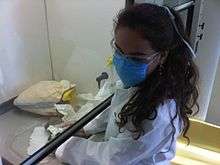Medical education

Medical education is education related to the practice of being a medical practitioner; either the initial training to become a physician (i.e., medical school and internship), or additional training thereafter (e.g., residency and fellowship).
Medical education and training varies considerably across the world. Various teaching methodologies have been utilised in medical education, which is an active area of educational research.[1]
Entry-level education

Entry-level medical education programs are tertiary-level courses undertaken at a medical school. Depending on jurisdiction and university, these may be either undergraduate-entry (most of Europe, India, China), or graduate-entry programs (mainly Australia, Canada, United States).
In general, initial training is taken at medical school. Traditionally initial medical education is divided between preclinical and clinical studies. The former consists of the basic sciences such as anatomy, physiology, biochemistry, pharmacology, pathology. The latter consists of teaching in the various areas of clinical medicine such as internal medicine, pediatrics, obstetrics and gynecology, psychiatry, general practice and surgery. However, medical programs are using systems-based curricula in which learning is integrated, and several institutions do this. In the United States, until quite recently, the requirements for the M.D. degree did not include even one course in human nutrition. Today, this omission has been rectified, at least to the extent that one such course is required.
There has been a proliferation of programmes that combine medical training with research (M.D./Ph.D.) or management programmes (M.D./ MBA), although this has been criticised because extended interruption to clinical study has been shown to have a detrimental effect on ultimate clinical knowledge.[2]
Postgraduate education
Following completion of entry-level training, newly graduated doctors are often required to undertake a period of supervised practice before full registration is granted; this is most often of one-year duration and may be referred to as an "internship" or "provisional registration" or "residency".

Further training in a particular field of medicine may be undertaken. In the U.S., further specialized training, completed after residency is referred to as "fellowship". In some jurisdictions, this is commenced immediately following completion of entry-level training, while other jurisdictions require junior doctors to undertake generalist (unstreamed) training for a number of years before commencing specialisation.
Education theory itself is becoming an integral part of postgraduate medical training. Formal qualifications in education are also becoming the norm for medical school educators, who are increasingly accountable for their students.
Continuing medical education
In most countries, continuing medical education (CME) courses are required for continued licensing.[3] CME requirements vary by state and by country. In the USA, accreditation is overseen by the Accreditation Council for Continuing Medical Education (ACCME). Physicians often attend dedicated lectures, grand rounds, conferences, and performance improvement activities in order to fulfill their requirements.
Online learning
It is becoming more and more common for medical education around the world to be supported by online teaching, usually within learning management systems (LMSs) or virtual learning environments (VLEs).[4][5]
Research areas into online medical education include practical applications with virtual patients and virtual medical records.[6]
- Dental Anatomy Software[7]
- Virtual Dental Patients
Virtual Dental Patients is a combination of systems and methods that read digital medical records and create three-dimensional image simulations. This computerized method provides an accurate representation of the surface anatomy of hard and soft tissues, tooth contacts, and motion of the patient’s jaw while the teeth are in contact. Virtual Dental Patients provide valuable information in the diagnosis, prognosis, and outcome assessment of the patient’s dental health. This invention represents a paradigm shift in clinical measurement for dentistry.
Example of medical education systems
At present, in the United Kingdom, a typical medicine course at university is 5 years or 4 years if the student already holds a degree. Among some institutions and for some students, it may be 6 years (including the selection of an intercalated BSc—taking one year—at some point after the pre-clinical studies). All programs culminate in the Bachelor of Medicine and Surgery degree (abbreviated MBChB, MBBS, MBBCh, BM, etc.). This is followed by 2 clinical foundation years afterward, namely F1 and F2, similar to internship training. Students register with the UK General Medical Council at the end of F1. At the end of F2, they may pursue further years of study. The system in Australia is very similar, with registration by the Australian Medical Council (AMC).
In the US and Canada, a potential medical student must first complete an undergraduate degree in any subject before applying to a graduate medical school to pursue an (M.D. or D.O.) program. U.S. medical schools are almost all four-year programs. Some students opt for the research-focused M.D./Ph.D. dual degree program, which is usually completed in 7–10 years. There are certain courses that are pre-requisite for being accepted to medical school, such as general chemistry, organic chemistry, physics, mathematics, biology, English, labwork, etc. The specific requirements vary by school.
In Australia, there are two pathways to a medical degree. Students can choose to take a five- or six-year undergraduate medical degree Bachelor of Medicine/Bachelor of Surgery (MBBS or BMed) as a first tertiary degree directly after secondary school graduation, or first complete a bachelor's degree (in general three years, usually in the medical sciences) and then apply for a four-year graduate entry Bachelor of Medicine/Bachelor of Surgery (MBBS) program.
See:
- Medical education in Australia
- Medical education in Canada
- Medical education in China
- Medical education in Hong Kong
- Medical education in India
- Medical education in Jordan
- Medical education in Norway
- Medical education in Panama
- Medical education in the Philippines
- Medical education in South Africa
- Medical education in Uganda
- Medical education in the United Kingdom
- Medical education in the United States
See also
- Doctors to Be (an occasional series on BBC television)
- INMED
- List of medical schools
- List of medical education agencies
- Objective Structured Clinical Examination
- Progress testing
- Validation of foreign studies and degrees
- Virtual Patients
References
- ↑ Flores-Mateo G; Argimon JM (26 July 2007). "Evidence based practice in postgraduate healthcare education: A systematic review". BMC Health Serv Res. 7: 119. doi:10.1186/1472-6963-7-119. PMC 1995214
 . PMID 17655743.
. PMID 17655743. - ↑ Dyrbye LN; Thomas MR; Natt N; Rohren CH (2007). "Prolonged Delays for Research Training in Medical School are Associated with Poorer Subsequent Clinical Knowledge". J Gen Intern Med. 22 (8): 1101–6. doi:10.1007/s11606-007-0200-x. PMC 2305740
 . PMID 17492473.
. PMID 17492473. - ↑ Ahmed K; Ashrafian H; Hanna GB; Darzi A; et al. (Oct 2009). "Assessment of specialists in cardiovascular practice" (PDF). Nature Reviews Cardiology. 6 (10).
- ↑ Ellaway R; Masters K. (2008). "AMEE Guide 32: e-Learning in medical education Part 1: Learning, teaching and assessment". Med Teach. 30 (5): 455–473. doi:10.1080/01421590802108331. PMID 18576185.
- ↑ Masters K; Ellaway R (2008). "e-Learning in medical education Guide 32 Part 2: Technology, management and design". Med Teach. 30 (5): 474–489. doi:10.1080/01421590802108349. PMID 18576186.
- ↑ Favreau, Annie. "Minnesota Virtual Clinic Medical Education Software". Regents of the University of Minnesota. Retrieved 2011-09-13.
- ↑ Favreau, Annie. "Three Dimensional Dental Anatomy Software". Regents of the University of Minnesota. Retrieved 2011-09-19.
External links
| Wikisource has the text of the 1911 Encyclopædia Britannica article Medical Education. |
- Academy of Medical Educators
- Inside PA Training - the Journal of Physician Assistant Education and Careers
- Meducation.net -The medical education network sharing thousands of medical resources